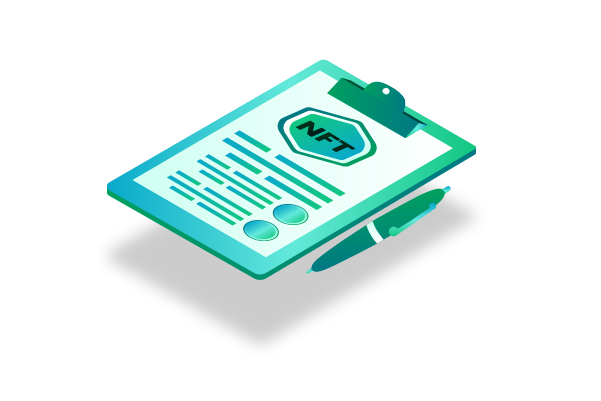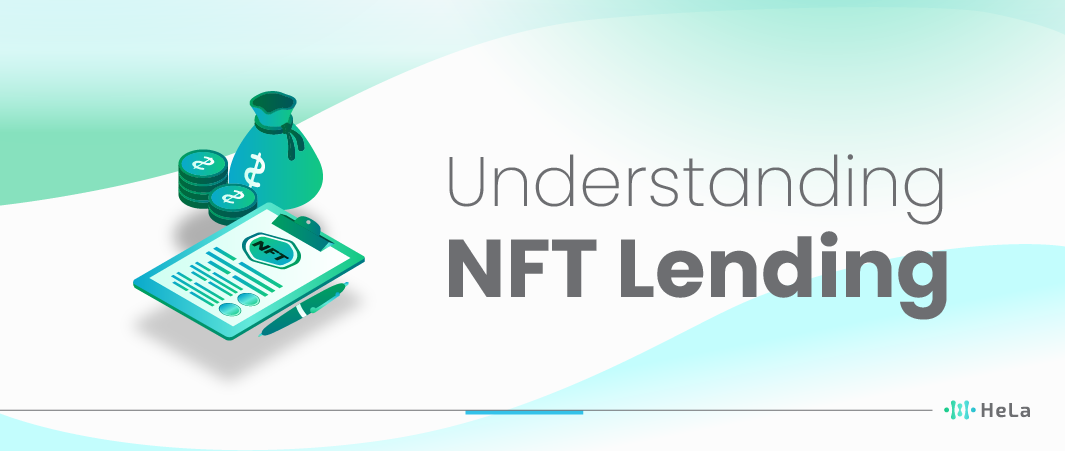In recent years, with the rise of blockchain technology and cryptocurrencies gaining mainstream acceptance, a fascinating new asset class has emerged: Non-Fungible Tokens (NFTs). These one-of-a-kind digital assets represent ownership of specific items or content on the blockchain, and their popularity has skyrocketed. As NFT markets continue to expand, a novel financial service called NFT lending is gaining traction. NFT lending allows individuals to use their valuable NFTs as collateral for loans, changing the dynamics of both the financial and art worlds.
NFT lending, at its core, enables NFT owners to unlock liquidity from their digital assets without needing to sell them. This innovative approach allows collectors, artists, and creators to access funds for various purposes, from investing in more NFTs to covering personal expenses. However, participants should exercise caution and be aware of potential risks, including the volatility of NFT markets and the risk of losing their collateral if they cannot repay the loan. As the NFT lending landscape evolves, it is crucial for individuals to conduct thorough research and due diligence before engaging in these transactions.
In this rapidly evolving space, NFT lending offers a unique way to bridge the gap between the digital and traditional financial worlds. It empowers NFT enthusiasts and creators to leverage their digital assets while introducing a set of challenges that require careful consideration. As NFT lending continues to reshape the financial landscape, staying informed and cautious will be key for those looking to explore this innovative avenue.
What Is NFT Lending?

NFT lending is like a digital pawnshop for NFT owners. It lets people who own these unique digital collectibles use them as collateral to borrow money. This means you can get cash without giving up your beloved NFTs. However, like any new trend, it’s crucial to grasp how NFT lending works to make the most of it while avoiding any tricky situations.
In NFT lending, you essentially temporarily trade your NFT for a loan. You get some funds, and in return, your NFT serves as a guarantee until you pay back the loan. This helps NFT collectors access cash without selling their precious digital treasures. Just be aware that the NFT market can be unpredictable, and the value of your NFT collateral might change, so it’s essential to stay informed about the latest trends and developments in NFT lending to make smart choices.
So, if you’re an NFT owner looking to unlock some liquidity, NFT lending could be a useful option. Just remember to stay in the loop about the world of NFTs and lending to navigate this emerging market safely.
The Mechanics of NFT Lending
NFT lending, a relatively new phenomenon in the world of blockchain and cryptocurrency, operates similarly to traditional asset-backed lending but with a unique twist. In this lending model, NFT (Non-Fungible Token) owners who find themselves in need of liquidity but are either unwilling or unable to part with their prized digital assets can use them as collateral to secure a loan. Just as with traditional lending, NFT lending involves borrowers and lenders, but the assets being used as collateral are unique digital collectibles or creations represented by NFTs.
Here’s a more detailed breakdown of how NFT lending works:
1. NFT Owner Seeks Liquidity
The process begins when an NFT owner decides that they require funds for a specific purpose, such as covering immediate expenses, making investments, or seizing other opportunities. Rather than selling their NFT, which might hold sentimental or long-term value, they opt for NFT lending.
2. Collateralizing the NFT
The NFT owner offers their NFT as collateral for a loan. This means that they temporarily transfer ownership rights of the NFT to the lender as a security measure for the loan. The NFT’s unique digital properties, provenance, and ownership history are all recorded on the blockchain, ensuring transparency and security throughout the lending process.
3. Lender Provides Funds
The lender, who is often a cryptocurrency investor or entity specializing in NFT lending, provides the borrower with funds in the form of cryptocurrency, such as Bitcoin or Ethereum. The amount of cryptocurrency lent is typically determined based on the perceived value of the NFT and other factors, including the borrower’s creditworthiness.
4. Security and Default
While holding the NFT as collateral, the lender is protected in case the borrower defaults on the loan. If the borrower fails to meet the agreed-upon repayment terms, the lender has the legal right to claim ownership of the NFT. This allows the lender to potentially sell the NFT in the open market to recoup the borrowed funds and any accrued interest.
5. Loan Terms
Interest rates, loan durations, and loan-to-value (LTV) ratios can vary significantly depending on the lending platform, the perceived value of the NFT, and market demand. Borrowers and lenders negotiate these terms, and they may also depend on factors like the rarity of the NFT, its historical price performance, and its overall desirability in the market.
It’s important to note that NFT lending is still an emerging and evolving market, and it carries risks for both borrowers and lenders. The value of NFTs can be highly volatile, and the lending terms may not always align with the long-term value or sentimental attachment that NFT owners have to their digital assets. Therefore, borrowers should carefully consider their ability to meet repayment obligations, and lenders should conduct thorough due diligence before engaging in NFT lending transactions. As the NFT lending ecosystem matures, it’s likely that regulatory and industry standards will develop to provide more stability and protection for all parties involved.
Also Read: What Is Solidity Interface? A Comprehensive Guide with Practical Examples
Key Market Trends in NFT Lending

Non-Fungible Tokens (NFTs) have rapidly gained popularity in recent years, leading to the emergence of various market trends in NFT lending. NFT lending refers to the practice of borrowing or lending NFTs, often in exchange for cryptocurrencies or stablecoins. Here are some key market trends in NFT lending:
Collateralization and Decentralization
- NFT lending platforms increasingly rely on decentralized finance (DeFi) protocols. Users can collateralize their NFTs to borrow assets or lend their NFTs to earn interest. This decentralized approach eliminates the need for intermediaries and provides users with more control over their assets.
Fractional Ownership
- Fractionalized NFT ownership has gained traction, allowing users to purchase and trade fractions of high-value NFTs. This trend has led to the emergence of lending markets specifically for fractionalized NFTs, where users can borrow against their ownership stake.
Liquidity Pools
- NFT lending platforms often utilize liquidity pools to facilitate borrowing and lending. Users can contribute their NFTs to these pools, and borrowers can access assets from the pool by providing sufficient collateral. Liquidity providers earn fees and interest from these pools.
Risk Assessment and Insurance
- Due to the unique nature of NFTs, risk assessment and insurance have become crucial in NFT lending. Platforms are incorporating advanced risk assessment models to determine the value and risk associated with NFT collateral. Additionally, some platforms offer insurance solutions to protect lenders and borrowers from potential losses.
Gaming and Metaverse Integration
- NFT lending has expanded into the gaming and metaverse sectors. Gamers can lend rare in-game NFT assets to earn passive income, while virtual real estate owners can use their NFT properties as collateral for loans within the metaverse.
Yield Farming and Incentives
- To attract users, NFT lending platforms often offer yield farming opportunities and incentives. Users can earn additional rewards by participating in platform governance or by staking platform-specific tokens.
NFT Standards and Interoperability
- The development of interoperable NFT standards, such as ERC-721 and ERC-1155, has made it easier for users to lend and borrow NFTs across different platforms and ecosystems. This trend encourages cross-platform NFT lending.
Regulatory Considerations
- Regulatory scrutiny is increasing in the NFT lending space. As governments and financial authorities begin to address NFT-related activities, platforms are adapting to comply with evolving regulations to ensure long-term sustainability.
NFT Lending Marketplaces
- Specialized NFT lending marketplaces are emerging, providing a dedicated platform for users to access NFT lending services. These marketplaces often offer user-friendly interfaces and innovative features to attract a broader user base.
Secondary Market Trading
- Some NFT lending platforms are exploring secondary market trading options for the NFTs held as collateral. This enables users to trade or sell their NFT collateral while their loan is still active, adding flexibility to the lending process.
Rising Demand for Liquidity
- As the NFT market grows, more holders seek ways to leverage their holdings without parting with their assets. This has driven a surge in demand for NFT lending services.
Emergence of NFT Lending Platforms
- Several platforms have sprouted to facilitate NFT-backed loans. These platforms often include mechanisms to appraise NFT values, match lenders with borrowers, and ensure secure transactions.
Diverse Collateral Acceptance
- While early NFT lending focused on high-value art or collectibles, the trend is moving towards accepting a broader range of NFTs, including virtual real estate and digital wearables.
Integration with Traditional Finance
- Some innovative financial institutions are exploring ways to integrate NFT lending into more conventional finance systems, bridging the gap between digital and traditional assets.
Overall, NFT lending is an evolving and dynamic market with numerous trends shaping its development. As the NFT space continues to grow and mature, it’s likely that new trends and innovations will emerge, further expanding the possibilities and opportunities within the NFT lending ecosystem.
Risks Associated with NFT Lending
NFT lending, also known as non-fungible token lending, is a relatively new and innovative financial service that has emerged within the cryptocurrency and blockchain space. It allows NFT owners to use their digital assets as collateral to borrow funds or other NFTs. While it offers various opportunities and benefits, it also comes with several risks and challenges that need to be considered. Here is a more detailed exploration of the risks associated with NFT lending:
Volatility Risk
NFT values can be highly volatile. The value of an NFT used as collateral may decrease significantly during the loan term, which could lead to liquidation if the value falls below a certain threshold. Borrowers might find themselves needing to repay a loan with assets worth less than what they borrowed.
Smart Contract Vulnerabilities
NFT lending platforms operate using smart contracts, which are susceptible to bugs and vulnerabilities. If a smart contract has a vulnerability, it can be exploited by malicious actors, potentially leading to the loss of collateral or other assets on the platform.
Lack of Regulation
The NFT lending space is relatively unregulated, which means there may be fewer safeguards for borrowers and lenders. Without proper oversight, fraudulent lending platforms or scams can emerge, putting users’ assets at risk.
Counterparty Risk
When lending or borrowing NFTs, there is a counterparty risk involved. Borrowers may default on their loans, leaving lenders with a loss if they cannot recover their assets through the platform’s mechanisms.
Illiquidity Risk
Some NFTs, especially those representing unique digital art or collectibles, can be illiquid. If a borrower has an illiquid NFT as collateral, it may be challenging to sell it quickly in the event of a margin call or liquidation, leading to losses.
Legal and Regulatory Risks
The legal and regulatory environment for NFTs and NFT lending is still evolving. Changes in laws or regulations could impact the legality and operation of NFT lending platforms, potentially affecting the rights and protections of users.
Platform Risk
The choice of NFT lending platform matters. Some platforms may lack security measures, transparent practices, or a robust user base. Users need to thoroughly research and assess the reputation and security of the platform they choose to use.
Market Risk
NFT prices are influenced by market sentiment, trends, and speculation. Rapid price fluctuations can impact both borrowers and lenders. A significant market downturn can result in a wave of liquidations and losses.
Custody Risk
When NFTs are used as collateral, they are typically held in custody by the lending platform. If the platform experiences a security breach or insolvency, there is a risk of losing the collateral.
Technology Risk
The NFT ecosystem relies on blockchain technology, which is still relatively new and evolving. Technological failures, such as network congestion or software bugs, can disrupt lending platforms and transactions.
Reputation Risk
NFT lending platforms heavily depend on their reputation within the community. Negative publicity, hacks, or controversies surrounding a platform can lead to a loss of trust and value.
To mitigate these risks, individuals interested in NFT lending should conduct thorough due diligence, diversify their holdings, use reputable platforms, and stay informed about the evolving regulatory landscape. Additionally, using risk management strategies, such as setting appropriate collateral ratios and managing exposure, can help reduce the potential impact of these risks.
Also Read: Disadvantages and Advantages of Decentralization
Navigating the NFT Lending Landscape

When it comes to NFT lending, there are a few key things to keep in mind for both borrowers and lenders. For those looking to borrow against their NFTs, it’s crucial to have a good grasp of your NFT’s market value. Make sure you’re comfortable with the loan-to-value ratio (LTV) and interest rates offered by the lending platform you choose. Remember, not all NFTs are created equal, so knowing the worth of your digital asset is essential to make an informed borrowing decision. Equally important is selecting a reputable NFT lending platform to ensure a secure and trustworthy transaction.
On the flip side, if you’re considering becoming an NFT lender, diversification is the name of the game. Rather than betting heavily on a single high-value NFT, spread your risk by lending smaller amounts against a variety of NFTs. This strategy can help protect your investments and minimize potential losses in case of market volatility. Additionally, staying updated on market trends and educating yourself is paramount. The NFT landscape is dynamic, and being well-informed will empower you to make smart lending decisions and adapt to changing conditions in the world of NFT lending.
In the exciting world of NFT lending, borrowers and lenders alike must approach it with caution and knowledge. Understanding the value of your NFTs, choosing reputable platforms, diversifying lending portfolios, and staying informed about market trends are all essential steps to navigate the NFT lending landscape successfully. Whether you’re looking to leverage your NFTs or invest in them, these principles can help you make sound decisions in this evolving digital asset ecosystem.
Conclusion
NFT lending is undeniably an exciting frontier in the financial landscape. It represents the convergence of traditional finance mechanisms with the novel world of digital assets. As the NFT market continues its meteoric rise, lending services offer both opportunities and challenges to participants.
While the allure of unlocking liquidity from digital assets is tempting, it’s paramount to approach NFT lending with a well-informed perspective. By understanding market trends and being aware of associated risks, stakeholders can navigate this dynamic space effectively.
Ultimately, as with all financial endeavors, due diligence, continuous learning, and risk management will be the cornerstones of success in the NFT lending arena.
Disclaimer: The information provided by HeLa Labs in this article is intended for general informational purposes and does not reflect the company’s opinion. It is not intended as investment advice or recommendations. Readers are strongly advised to conduct their own thorough research and consult with a qualified financial advisor before making any financial decisions.

I am Carina Caringal, a technical writer specializing in blockchain engineering concepts, decentralized systems, crypto infrastructure, and Web3 technologies. My work focuses on analyzing and translating complex technical mechanisms into precise, structured, and insightful content for both developers and non-technical readers who want a deeper understanding of the decentralized ecosystem.
My background in blockchain and cryptocurrency is rooted in years of independent research, continuous learning, and hands-on exploration across multiple protocols and network architectures. I study the underlying mechanics of distributed ledger technology, from consensus algorithms and smart contract logic to network scalability, security models, cryptographic principles, and interoperability frameworks. This technical foundation shapes the way I approach every article, ensuring accuracy, depth, and relevance.
- Carina Caringalhttps://helalabs.com/blog/author/carina-caringal/
- Carina Caringalhttps://helalabs.com/blog/author/carina-caringal/
- Carina Caringalhttps://helalabs.com/blog/author/carina-caringal/
- Carina Caringalhttps://helalabs.com/blog/author/carina-caringal/

